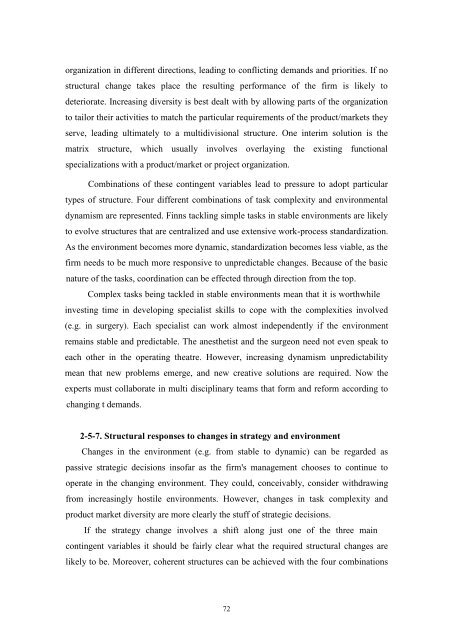DSpace at Khazar University
DSpace at Khazar University
DSpace at Khazar University
Create successful ePaper yourself
Turn your PDF publications into a flip-book with our unique Google optimized e-Paper software.
organiz<strong>at</strong>ion in different directions, leading to conflicting demands and priorities. If no<br />
structural change takes place the resulting performance of the firm is likely to<br />
deterior<strong>at</strong>e. Increasing diversity is best dealt with by allowing parts of the organiz<strong>at</strong>ion<br />
to tailor their activities to m<strong>at</strong>ch the particular requirements of the product/markets they<br />
serve, leading ultim<strong>at</strong>ely to a multidivisional structure. One interim solution is the<br />
m<strong>at</strong>rix structure, which usually involves overlaying the existing functional<br />
specializ<strong>at</strong>ions with a product/market or project organiz<strong>at</strong>ion.<br />
Combin<strong>at</strong>ions of these contingent variables lead to pressure to adopt particular<br />
types of structure. Four different combin<strong>at</strong>ions of task complexity and environmental<br />
dynamism are represented. Finns tackling simple tasks in stable environments are likely<br />
to evolve structures th<strong>at</strong> are centralized and use extensive work-process standardiz<strong>at</strong>ion.<br />
As the environment becomes more dynamic, standardiz<strong>at</strong>ion becomes less viable, as the<br />
firm needs to be much more responsive to unpredictable changes. Because of the basic<br />
n<strong>at</strong>ure of the tasks, coordin<strong>at</strong>ion can be effected through direction from the top.<br />
Complex tasks being tackled in stable environments mean th<strong>at</strong> it is worthwhile<br />
investing time in developing specialist skills to cope with the complexities involved<br />
(e.g. in surgery). Each specialist can work almost independently if the environment<br />
remains stable and predictable. The anesthetist and the surgeon need not even speak to<br />
each other in the oper<strong>at</strong>ing the<strong>at</strong>re. However, increasing dynamism unpredictability<br />
mean th<strong>at</strong> new problems emerge, and new cre<strong>at</strong>ive solutions are required. Now the<br />
experts must collabor<strong>at</strong>e in multi disciplinary teams th<strong>at</strong> form and reform according to<br />
changing t demands.<br />
2-5-7. Structural responses to changes in str<strong>at</strong>egy and environment<br />
Changes in the environment (e.g. from stable to dynamic) can be regarded as<br />
passive str<strong>at</strong>egic decisions insofar as the firm's management chooses to continue to<br />
oper<strong>at</strong>e in the changing environment. They could, conceivably, consider withdrawing<br />
from increasingly hostile environments. However, changes in task complexity and<br />
product market diversity are more clearly the stuff of str<strong>at</strong>egic decisions.<br />
If the str<strong>at</strong>egy change involves a shift along just one of the three main<br />
contingent variables it should be fairly clear wh<strong>at</strong> the required structural changes are<br />
likely to be. Moreover, coherent structures can be achieved with the four combin<strong>at</strong>ions<br />
72

















